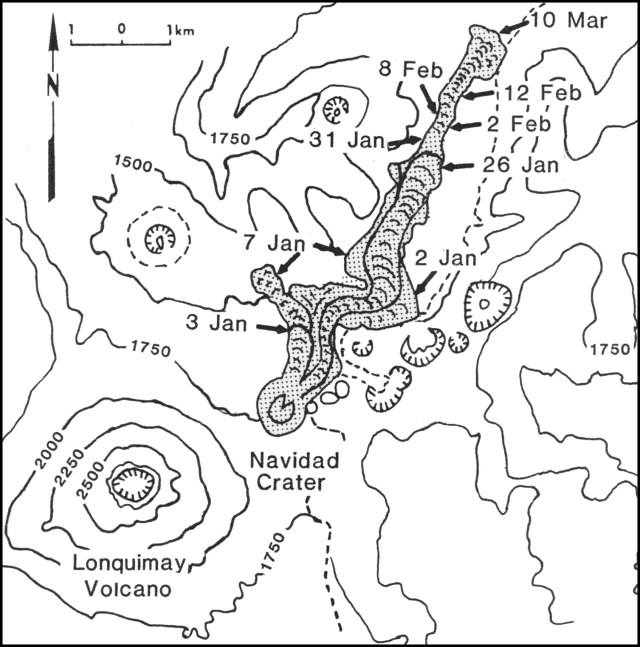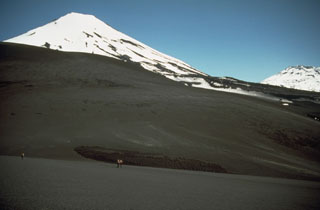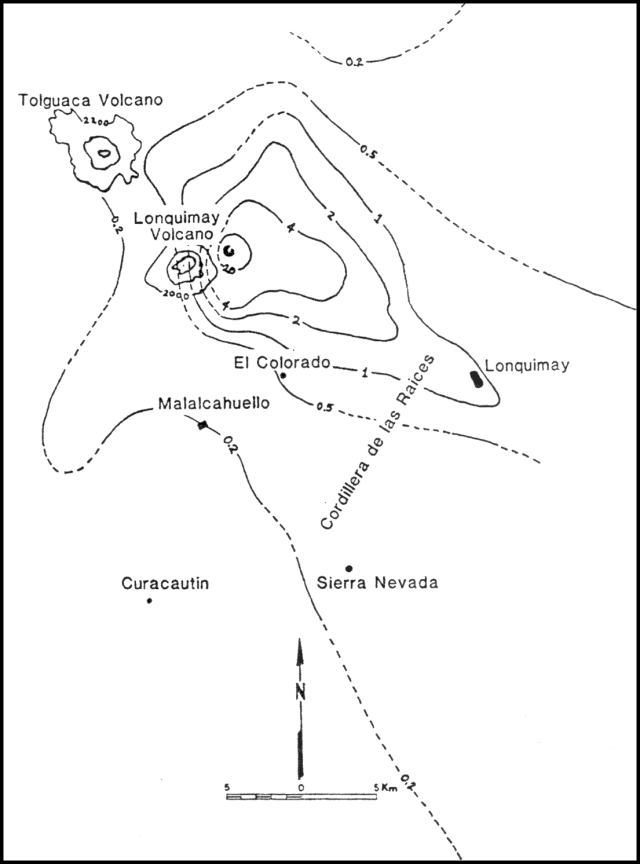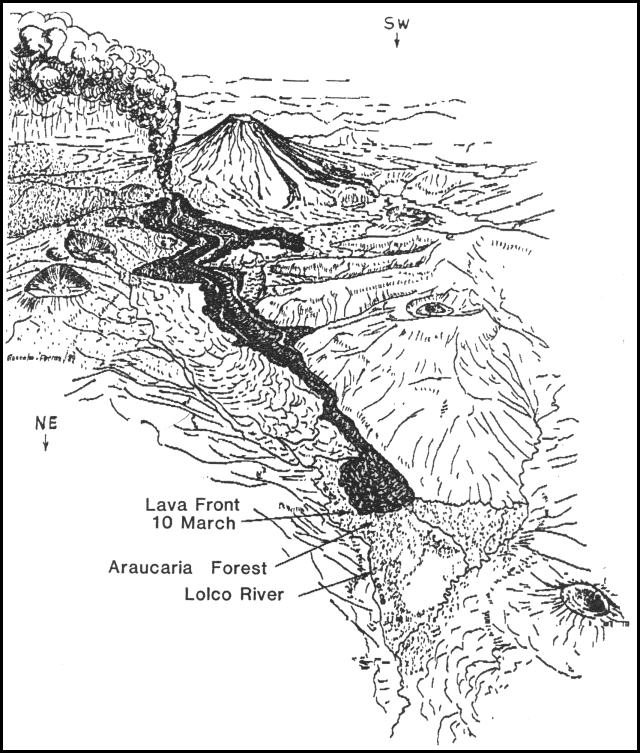Report on Lonquimay (Chile) — February 1989
Scientific Event Alert Network Bulletin, vol. 14, no. 2 (February 1989)
Managing Editor: Lindsay McClelland.
Lonquimay (Chile) Tephra ejection and lava extrusion continue
Please cite this report as:
Global Volcanism Program, 1989. Report on Lonquimay (Chile) (McClelland, L., ed.). Scientific Event Alert Network Bulletin, 14:2. Smithsonian Institution. https://doi.org/10.5479/si.GVP.SEAN198902-357100
Lonquimay
Chile
38.379°S, 71.586°W; summit elev. 2832 m
All times are local (unless otherwise noted)
The eruption was continuing in mid-March 1989. Eruptive activity and seismicity had declined substantially on 6 January. Eruption intensity increased slightly the next day, continuing with alternating pulses of greater and lesser explosivity; eruption columns rose a maximum of 2,500 m above the crater. Seismicity remained at relatively low levels through 11 January, then began a strong increase with a M 4.6 event on 12 January at 0011. The number of events reached 25/hour on the 12th, with 156 shocks recorded that day. A M 5.0 earthquake was one of 115 recorded the next day. Vigorous ejection of dense ash/gas columns was accompanied by an increase in the output rate of the block lava flow. On 14 January, the flow was advancing at ~10 m/hour, had an average width of 300-400 m, and was ~10 m thick. The approximate length of its E lobe was 6 km, and its W lobe 3 km.
Navidad cone, built to a height of more than 200 m by early January, collapsed on 12 January, reducing its height. By 21 January, however, Carlos Varela (Univ de la Frontera) measured its dimensions at 185 m high, with a crater 295 m across and a 750-m basal diameter. Most of the ash produced by the eruption fell E and SE of the volcano (figure 6). Lonquimay village (roughly 20 km SE of the cone) recorded 1 cm of ash on 21 January, and tephra collected at the village had an andesitic composition (table 4). Seismicity remained centered in the NE flank of the volcano, without any apparent focal migration.
Table 4. Analysis by J. Martínez of ash (Lonquimay village) and bomb samples from the Lonquimay eruption. Courtesy of H. Moreno and P. Riffo.
| Component | Ash Sample | Bomb Sample |
| SiO2 | 57.48 | 58.65 |
| Al2O3 | 16.24 | 15.90 |
| TiO2 | 1.51 | 1.51 |
| Fe2O3 | 3.39 | 1.52 |
| FeO | 6.08 | 7.72 |
| MgO | 2.38 | 2.25 |
| CaO | 5.57 | 5.57 |
| Na2O | 5.04 | 4.95 |
| K2O | 0.99 | 0.95 |
| MnO | 0.23 | 0.22 |
| P2O5 | 0.43 | 0.42 |
| LOI | 0.65 | 0.57 |
| Total | 99.99 | 100.23 |
Explosive activity of varying intensity continued in late January and early February. The ash column rose 1,000-2,000 m above the crater, and was blown E to SE through 1 February, then NNW to SW 2-8 February (table 5). The rate of lava discharge had declined from ~5.0 x 106 m3/day 27 December-2 January to 1.4 x 106 m3/day 2-31 January and 0.75 x 106 m3/day 31 January-8 February. The rate of advance at the flow fronts had also declined, measuring 1-1.5 m/hour on 8 February. The flow covered an area of ~6.5 km2 with an average thickness of 12 m, yielding a volume of 78 x 106 m3. The longer eastern lobe had reached 7.3 km down the Lolco river valley from the crater (figure 7). Activity increased again on 14 February, with more vigorous ejection of a column of pyroclastics and gases, plus a slight increase in the emission rate of the block lava flow. Stronger seismicity was associated with the more vigorous eruption; events were felt at MM III or IV 50 km from the vent at about 0500, 0830, 0919, and 1040. Tephra ejection continued on 10 March, and the flow front in the Lolco river valley was >9 km from the crater (figure 8).
Table 5. Ashfall locations and directions from Lonquimay, 27 January-8 February and 2-9 March 1989. Courtesy of H. Moreno, P. Riffo, and G. Fuentealba.
| Date | Time Period | Direction | Ashfall |
| 27 Jan 1989 | -- | ESE | Las Raices (20 km SE), Lonquimay village (20 km ESE) |
| 28 Jan 1989 | -- | E | Las Raices |
| 29 Jan 1989 | -- | ESE | Las Raices, Lonquimay village |
| 30 Jan 1989 | -- | ESE | Las Raices, Lonquimay village |
| 31 Jan 1989 | morning | ESE | Las Raices, Lonquimay village |
| 31 Jan 1989 | afternoon | SE-S | Sierra Nevada, Malalcahuello (12 km S) |
| 01 Feb 1989 | -- | SE | El Colorado (10 km SE) |
| 02 Feb 1989 | morning | NNW | -- |
| 02 Feb 1989 | noon | NW | Tolguaca Volcano (10 km NW) |
| 02 Feb 1989 | afternoon | W-SW | Curacautin town (28 km SW) |
| 03 Feb 1989 | -- | W-SW | Curacautin town |
| 08 Feb 1989 | -- | NNW | Very well-defined over 120 km(Angol city) |
| 02 Mar 1989 | -- | SE-S | Sierra Nevada, Malacahuello |
| 06 Mar 1989 | -- | SE | El Colorado |
| 08 Mar 1989 | -- | N-NE | Lolco River valley |
| 09 Mar 1989 | -- | ESE-NE | Las Raices, Naranjo, Lonquimay village |
 |
Figure 7. Sketch map showing the advance of the lava flows during December 1988-10 March 1989. Courtesy of O. González-Ferrán, H. Moreno R., and P. Riffo A. |
Small forest fires caused by the flow in January and February were controlled by the National Forest Service (CONAF). Water around the E side of the volcano has a high chloride and sulfide content. Some cattle, ducks, and chickens died after ashfall on grass; exact cause of death was not specified.
Geological Summary. Lonquimay is a small, flat-topped, symmetrical stratovolcano of late-Pleistocene to dominantly Holocene age immediately SE of Tolguaca volcano. A glacier fills its summit crater and flows down the S flank. It is dominantly andesitic, but basalt and dacite are also found. The prominent NE-SW Cordón Fissural Oriental fissure zone cuts across the entire volcano. A series of NE-flank vents and scoria cones were built along an E-W fissure, some of which have been the source of voluminous lava flows, including those during 1887-90 and 1988-90, that extended out to 10 km.
Information Contacts: H. Moreno, Univ de Chile; O. González-Ferrán, Univ de Chile; P. Riffo and G. Fuentealba, Univ de la Frontera.



